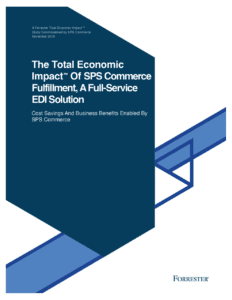Determining the EDI Cost Savings for Your Business
Companies invest in retail technologies with the expectation that it will make their business more efficient, save time and money, or help them to grow. To prioritize these investments, businesses look at metrics such as the payback period, return on investment (ROI), and net present value. You can calculate your potential EDI cost savings in the same way.
In late 2019, SPS Commerce commissioned Forrester Consulting to research and published a Total Economic Impact study. This report quantifies the cost savings and business benefits of SPS Commerce Fulfillment, a full-service EDI solution, to a high-growth manufacturer, Peter Grimm.
Forrester Consulting assessed the EDI software cost and the quantifiable benefits in the new study. This cost-benefit analysis of EDI of SPS Fulfillment was thorough and factual. Forrester’s interviews and subsequent cost-benefit analysis of EDI found that Peter Grimm has experienced benefits of $1 million over three years, a payback period of fewer than three months, and an ROI of 372%. The study offers many examples of how to calculate the true cost of EDI software that you can apply to your business.
Calculate Your EDI Cost Savings
So, how can you use this study to calculate your full-service EDI cost savings? Here are a few tips:
Determine the cost of manual processes.
Rekeying orders into a shipping or accounting system takes time, especially during high-demand periods. Peter Grimm eliminated unnecessary manual entry by integrating EDI with its ERP system, NetSuite. This automation saves measurable staff time and reduces errors. Peter Grimm saved more than $112K over three years by eliminating the need for temp employees to enter orders during their peak season when orders exceeded 3,000 per month. Tally the time your staff is spending on this function, and you’ll see it quickly adds up.
Add up your staffing costs.
Salaries and temps to support new systems can add up quickly and diminish the ROI quickly. With a full-service EDI offering, suppliers like Peter Grimm avoid hiring full-time staff to manage retailer changes and document processing. For this supplier, Forrester identified a savings of $256K/three-year benefit present value (PV) by eliminating the need for internal resources dedicated to EDI. Another $460K (three-year NPV) of savings occurred by relying on SPS to deploy and test ongoing retailer changes to their EDI requirements. What is your staffing cost today to support EDI and is this expected to increase as you grow?
Identify the cost of order entry errors.
Manual processes produce errors. Peter Grimm estimated a standard error rate of 5% for its manual processes and an increase to a 33% error rate during peak seasons when temps were processing orders. You can calculate the cost of these errors across the supply chain, including chargebacks. For Peter Grimm, Forrester identified a savings of $295K/three-year benefit net present value (NPV) related to the dramatic reduction in errors costs eliminated by EDI automation.
“Our error liability is $0 with SPS and integration with our ERP system – you’re talking $50-$500 in chargebacks, just at a snap of a finger. We’re getting $0,” said Shute.
Forrester’s interviews and subsequent cost-benefit analysis of EDI found that Peter Grimm has experienced benefits of $1,000,000 million over three years, with a payback period of fewer than three months and an ROI of 372 percent.
Would you like to learn more about how to breakdown your potential EDI cost savings with SPS Fulfillment? Download the full study to see the details and apply it to your business.

Ready to experience Full-Service EDI?
Want to learn more about the cost savings and business growth possible with full-service EDI? Read the new Forrester study commissioned by SPS Commerce.
Download the report- Three Takeaways from SuiteWorld 2023 - October 30, 2023
- Built-for-NetSuite partner discussion: RF-SMART and SPS Commerce - October 27, 2023
- 5 common problems distributors face - October 26, 2023


RELATED POSTS
4 strategies to conquer lean inventor...
6 Advantages of Integrating Your Info...
Four keys to selecting the right EDI ...